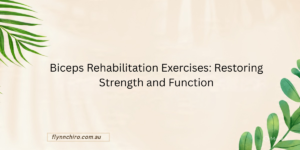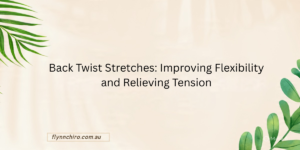
What is Good Posture? A Chiropractor’s Guide to Proper Alignment
When people hear “posture,” many immediately think of being told to “sit up straight.” But posture is more than a matter of appearance it affects your spine, joints, breathing, energy levels, and long-term health.
At my clinics in Melbourne CBD and Prahran, I see patients daily who are surprised to learn that their back pain, stiffness, or fatigue is directly tied to how they hold themselves throughout the day.
Whether you’re seated at a desk, standing on your feet all day, or hunched over your phone, posture plays a vital role in how your body performs and feels. This guide is here to help you understand what good posture really is, what causes it to break down, and how chiropractic care can support better alignment and wellbeing.
What is Good Posture?
Good posture refers to the ideal alignment of your body whether you’re standing, sitting, or lying down in a way that minimises strain on your muscles, joints, and ligaments. It allows your body to move efficiently and comfortably, reducing the risk of injury and fatigue while supporting optimal function.
When you maintain good posture, you’re not forcing your body into stiffness or rigidity. Rather, you’re positioning it in a way that works with gravity and respects the natural curves of your spine.
Key Features of Good Posture
Standing Posture

When standing with good posture:
- Your head should be upright, with ears aligned over the shoulders and chin parallel to the floor.
- Your shoulders stay relaxed and pulled slightly back, not rounded or hunched.
- Your spine retains its natural S-curve cervical, thoracic, and lumbar.
- Your hips remain even and neutral, without excessive forward or backward tilt.
- Your knees are soft and not locked.
- Your feet are hip-width apart, and your body weight is evenly distributed between both feet, ideally toward the balls of the feet.
Sitting Posture

When seated with good posture:
- Your back is supported, maintaining a gentle curve at the lower back with lumbar support.
- Your shoulders are relaxed, stacked directly above your hips, and not slouching forward.
- Your hips and knees form a 90-degree angle, with knees level with or slightly below the hips.
- Your feet rest flat on the floor or on a footrest never dangling.
- Your neck and head stay in a neutral position, with your chin level and head aligned over your shoulders.
The Real Benefits of Good Posture
The impact of good posture extends far beyond simply “looking confident.”
Physical and Functional Benefits
Good posture reduces strain on muscles and joints, which helps prevent fatigue and chronic discomfort. It improves breathing efficiency by giving the lungs space to expand, and it can enhance digestion by allowing internal organs to sit properly without being compressed.
Mental and Emotional Benefits
Posture also affects your mood and mental clarity. Standing or sitting upright can boost energy, support confidence, and contribute to a more positive mindset. The connection between posture and emotional wellbeing is often underestimated but strongly felt by patients once alignment improves.
When your body is aligned, it works with gravity, not against it. This means you use less energy, experience fewer aches, and feel more at ease in your own body.
Common Postural Problems I See in the Clinic
In both my Melbourne clinics, I regularly see postural habits that slowly chip away at spinal health.
Forward Head Posture
The head juts in front of the shoulders, placing extra strain on the neck and upper back muscles.
Rounded Shoulders
The chest collapses inward, and the upper back becomes overactive, common in desk workers.
Anterior Pelvic Tilt
This involves an excessive arch in the lower back, often caused by tight hip flexors and weak glutes.
Kyphosis
A hunched appearance in the upper back, sometimes linked to age or prolonged desk work.
Scoliosis
A lateral curvature of the spine that might not be visible until it causes discomfort or mobility issues.
Uneven Hips or Shoulders
These often stem from leg length discrepancies, muscular imbalances, or spinal misalignments.
These misalignments can create pain, movement restrictions, and long-term wear and tear.
Read Also: How Does Poor Posture Affect Digestion?
What Causes Poor Posture?
There’s rarely just one reason why someone develops poor posture. It’s usually a combination of modern lifestyle habits, physical imbalances, and environmental or emotional influences that gradually change how your body holds itself.
Sedentary Lifestyles and Daily Habits
Many postural issues start with how we live and work. Prolonged sitting at a desk, commuting, or being behind the wheel for long hours can cause the spine to round and shoulders to slump forward. Add to that the hours spent looking down at phones or laptops commonly referred to as “tech neck” and it’s no surprise that alignment suffers. A lack of physical movement throughout the day only makes things worse, as underused muscles weaken and adapt to poor positioning.
Muscle Imbalances and Physical Limitations
Posture depends on strength and flexibility in the right places. Weakness in the core or back muscles means the spine isn’t properly supported, while tightness in the chest, hip flexors, or hamstrings can pull the body out of alignment. Past injuries or trauma may also leave lasting effects, causing you to compensate in subtle but posturally damaging ways.
Sleep, Stress, and Everyday Load
Other contributing factors may not be as obvious but still affect your posture. Sleeping on an unsupportive mattress or with poor pillow positioning can disrupt spinal alignment. Emotional stress often causes unconscious tension in the shoulders and neck. Even simple habits like carrying a heavy bag on one shoulder or favouring one side of the body can lead to muscular imbalances over time.
Read Also: Can Some Headaches Be Associated with Poor Posture?
Why Chiropractors Focus on Posture
Posture isn’t just about aesthetics it’s about function. When your spine is misaligned, it can interfere with how your nerves, muscles, and joints work together. Left unaddressed, this can lead to pain, fatigue, and more serious issues like disc degeneration or joint wear.
As a chiropractor, I don’t just look at where the pain is I look at why it’s happening. Often, posture is the missing piece.
Posture Assessment at Flynn Chiro
During your first appointment, I assess your posture from multiple angles standing, walking, and sitting. I’ll look for imbalances, check joint mobility, and evaluate movement patterns.
In some cases, I may use posture analysis tools or refer to imaging. The goal is to get a clear picture of how your body is aligned and where we can make improvements.
How Chiropractic Care Can Help
Chiropractic care works by gently encouraging your spine and joints back toward a more functional position. Here’s how I typically support patients with posture issues:
- Chiropractic Adjustments: Targeted movements that restore motion to stuck joints
- Soft Tissue Work: Massage or trigger point therapy to ease tight muscles
- Corrective Exercises: Custom plans to strengthen weak areas and improve awareness
- Ergonomic Advice: Guidance on desk setup, sleep posture, lifting techniques, and more
For more complex spinal misalignments, I may integrate techniques like Chiropractic BioPhysics (CBP), which focuses on structural correction through adjustments, traction, and mirror-image posture training.
Practical Tips for Everyday Posture Support
Correcting posture doesn’t end when you leave the clinic. Here are some habits I recommend to support your spine at home and work:
- Adjust your workspace: Sit with feet flat, monitor at eye level, and lower back supported
- Move often: Stand, walk, or stretch every 30 minutes
- Do daily exercises: Chin tucks, wall angels, bridges, and bird dogs build awareness and strength
- Support your sleep: Use a firm mattress and pillows that maintain neck alignment
- Watch how you carry weight: Evenly distribute bags and avoid slouching when lifting
The key is consistency, not perfection.
How Long Does It Take to Correct Posture?
The answer varies. Some people feel better in just a few sessions, while others with more entrenched patterns may take several months. Age, occupation, lifestyle, and previous injuries all influence how quickly your body adapts.
The good news? Your body is remarkably adaptable with the right support, lasting change is absolutely achievable.
Real Patient Example: From Tech Neck to Relief
One of my patients, a 32-year-old accountant in Melbourne, came in with chronic neck pain and tension headaches. After an assessment, it was clear she had forward head posture from long hours at her laptop.
We began a series of spinal adjustments, added in daily chin tucks and shoulder retraction exercises, and made small tweaks to her desk setup. Within three weeks, she reported fewer headaches. By the sixth week, her posture had noticeably improved and so had her energy and confidence.
FAQs About Posture and Chiropractic
Can a chiropractor fix bad posture?
Chiropractic care can significantly improve posture by restoring spinal alignment and supporting healthy movement patterns. However, long-term results depend on follow-through doing the exercises, making ergonomic changes, and being mindful daily.
Are posture correctors helpful?
They can serve as a short-term reminder but aren’t a long-term fix. It’s better to strengthen the muscles that support posture naturally.
Can poor posture really affect breathing and digestion?
Yes. Slouched posture compresses the lungs and abdominal cavity, limiting breath capacity and slowing digestion. Improving alignment can lead to noticeable improvements.
Why Choose Flynn Chiro
At Flynn Chiro, I offer chiropractic care with a focus on posture, mobility, and nervous system health. With clinics in both Melbourne CBD and Prahran, I provide personalised, evidence-informed care tailored to your goals.
I don’t believe in a one-size-fits-all approach each plan is unique and built on collaboration, education, and long-term support.
Ready to Improve Your Posture?
Whether you’re struggling with pain or simply want to feel stronger and more aligned, I’d be happy to help. Book your posture assessment today and start your journey toward better posture and better health.
Book Now at Flynn Chiro – Melbourne CBD or Prahran
Flynn Chiro – Chiropractic care in Melbourne CBD and Prahran for posture, spinal health, and pain relief.

Flynn Pettersson
I am committed to providing exceptional chiropractic care in Melbourne, focused on your health and well-being.

Flynn Pettersson
I am committed to providing exceptional chiropractic care in Melbourne, focused on your health and well-being.






